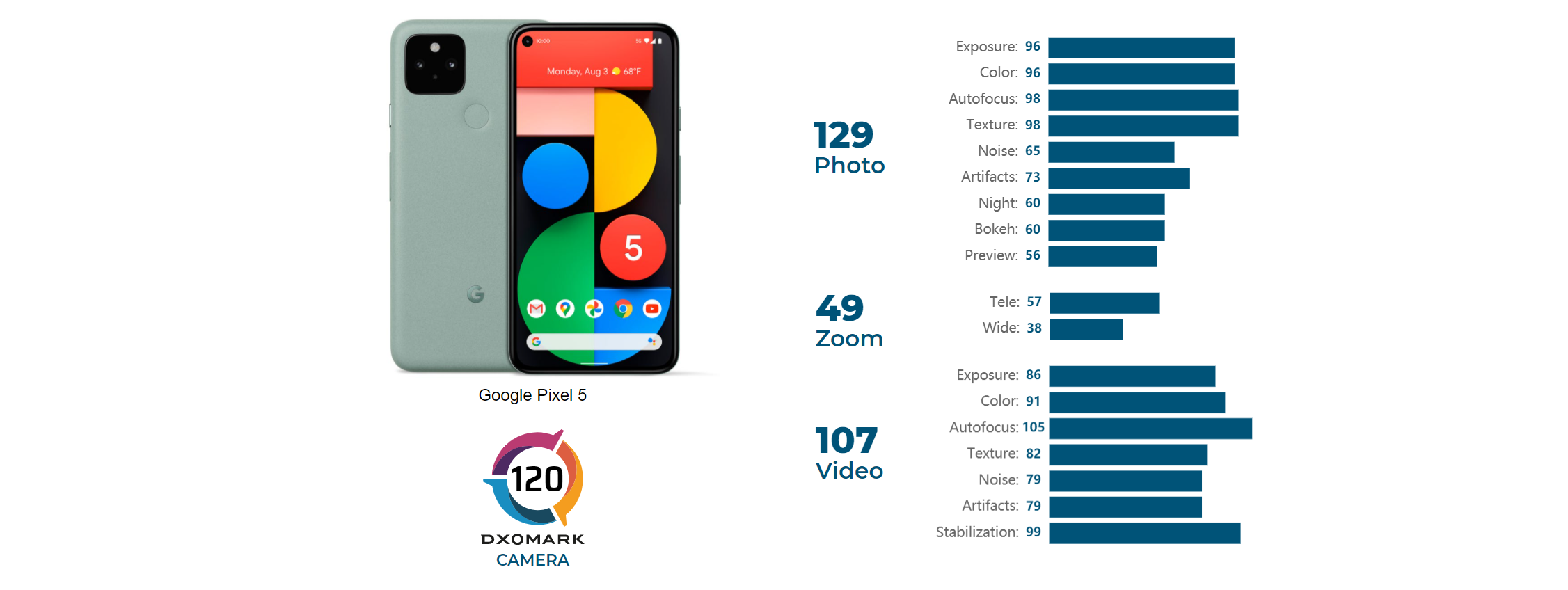
Despite the incredibly flawed and confusing nature of ranking cameras using a point-based system, the Google Pixel 5 has achieved a 120-point score from the defacto industry camera experts DxOMark — an 8-point bump over the Pixel 4 according to the French firm’s ranking system.
Considering that the Pixel 5 camera hardware offers a new focal length, but retains the same core camera sensor, the scoring seems all the more confusing. Even more so when you consider that the Pixel 5 actually lacks the Pixel Neural Core for faster on-device processing, although this hints that software is playing an even more crucial role in the camera performance of the firms latest flagship.
Unlike in previous years, where a 120-point total camera score would place a Pixel device firmly in the top 10 in DxOMark’s ranking, the Pixel 5 barely scrapes the top 15. This is no doubt due to the lack of a telephoto zoom lens, as DxOMark’s scoring system means a higher average based upon the number of lenses a device has at its disposal. For photos, the Pixel 5 received what seems like an impressive 129-point total.

As we have said, and many others will tell you, these scores are sometimes completely out of sync with what you see in the real world. However, criticisms aside, the rankings are a who’s who of the best in the business. DxOMark praised the exposure, color, and autofocus capabilities of the Pixel 5, alongside the way the device handles image artifacts.
With an overall DXOMARK Camera score of 120 points, the Google Pixel 5 puts in middle-ranking performance for devices evaluated under our latest testing protocol. The main camera fares slightly better with a Photo score of 129; and with key strengths for exposure, color, and autofocus, as well as well-controlled artifacts, the Pixel 5 delivers solid results for the most part.
Intricate details and texture are notable high points of the Pixel 5 camera system according to DxOMark, but noise appears to be an issue as they noted “visible noise in virtually all images” being a major weakness when using the digitally enhanced Super Res Zoom. This results in a 49-point score for the zoom capabilities, which is a marginal bump down compared to the 81-point score awarded to the Pixel 4 last year.
The ultra-wide-angle lens is a first on a Google Pixel series device, and DxOMark suggested that the field of view is “limited” but produces solid shots — something that we’ve proven ourselves:
Ultra-wide shots are pleasant enough for exposure and color, but its limited field of view puts it at a disadvantage compared to devices that squeeze more into the frame.
The Pixel 5 saw big strides in video performance and features, which has resulted in the highest video score for a Google device in DxOMark’s testing. A major commendation from DxO was the video autofocus, while the stabilization was also highly praised at 4K UHD.
A 107 score was awarded for the video portion of the Pixel 5 camera. The biggest complaints were the “underwhelming exposure and obvious color casts are also visible in low light”. However, bright and standard lighting conditions were strong suits of the Pixel 5 video shooting capabilities.
Oddly, DxOMark chose not to test the dedicated Night Sight mode on the Pixel 5, with no explanation as to why not. However, the conclusion is that the Pixel 5 manages to offer an excellent camera experience that goes toe-to-toe with devices costing double and triple:
With limited hardware, the Pixel 5 stands behind top performers for attributes such as texture, noise, bokeh, and zoom, where extra sensors and lenses really help. That said, its main camera delivers nice images, with the Google device delivering close to top scores for the basics of exposure, color, and autofocus.
Naturally, it will be interesting to see just how the scoring system evolves over the coming years, as it’s hard to seek out a bad flagship smartphone camera experience at this stage of 2020. Heck, we’d never suggest buying a device just from a DxOMark-awarded score. While we criticize the potentially flawed scoring system, it’s always important to note that camera preference is still highly subjective.
What do you think? Let us know down in the comments section below.
- Pixel 5 teardown reveals wireless charging cutout, use of clips to attach screen
- Google will fix Pixel 5 bug that leaves battery indicator stuck
- Google Pixel 5 can be repaired same-day at all uBreakiFix locations in the US
Author: Damien Wilde
Source: 9TO5Google



